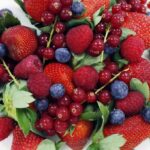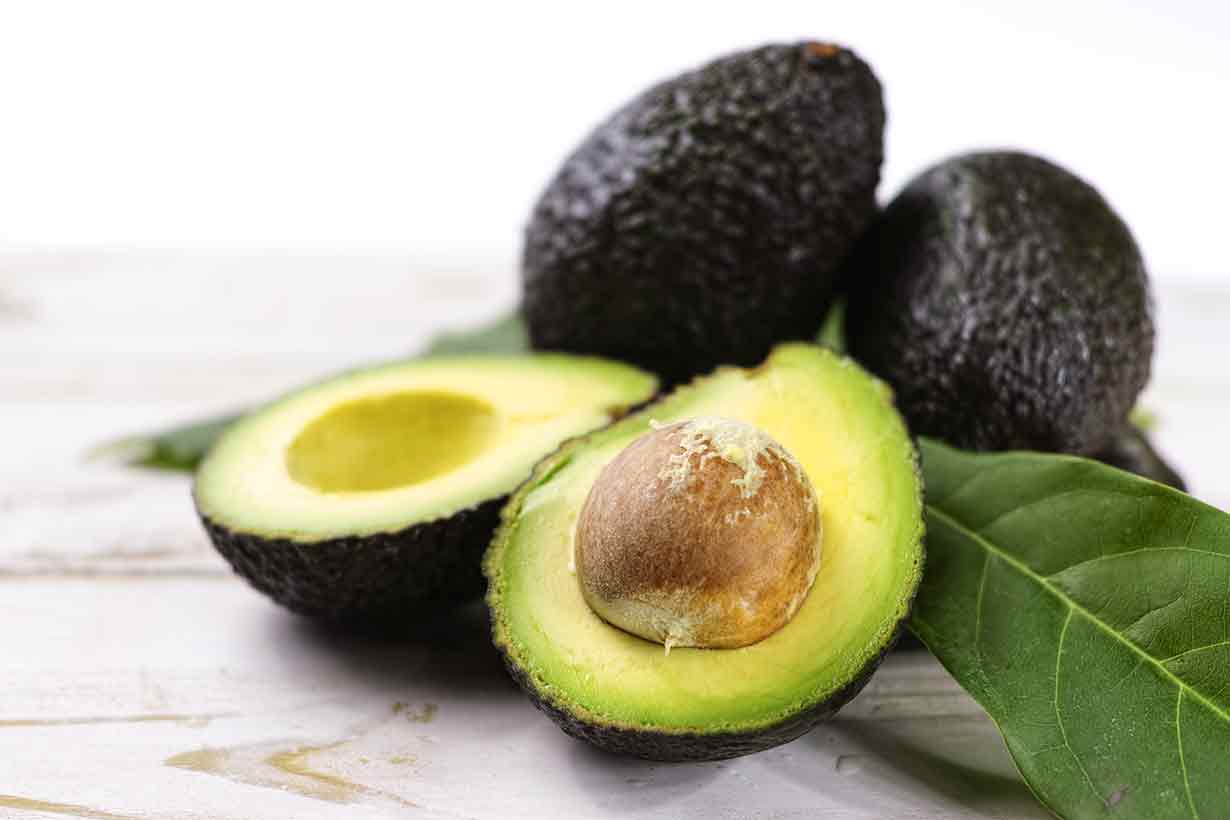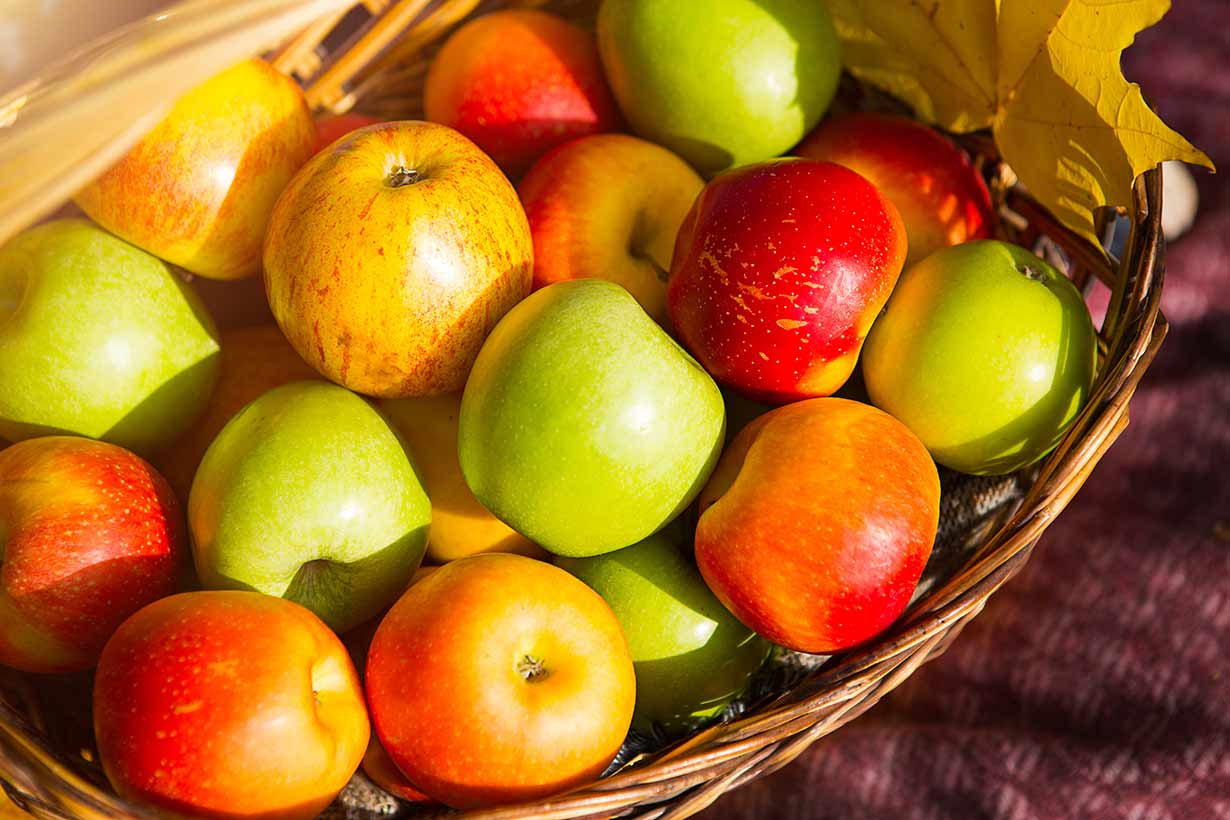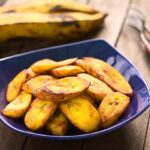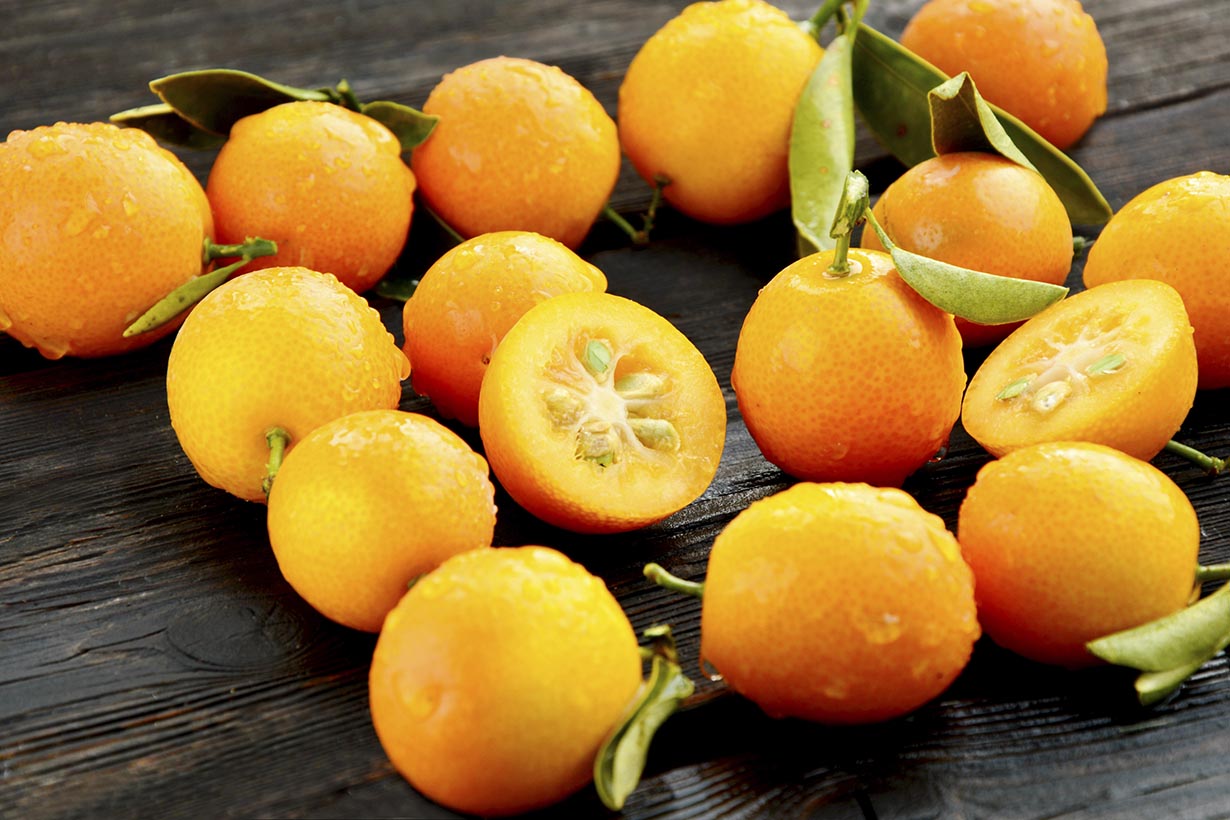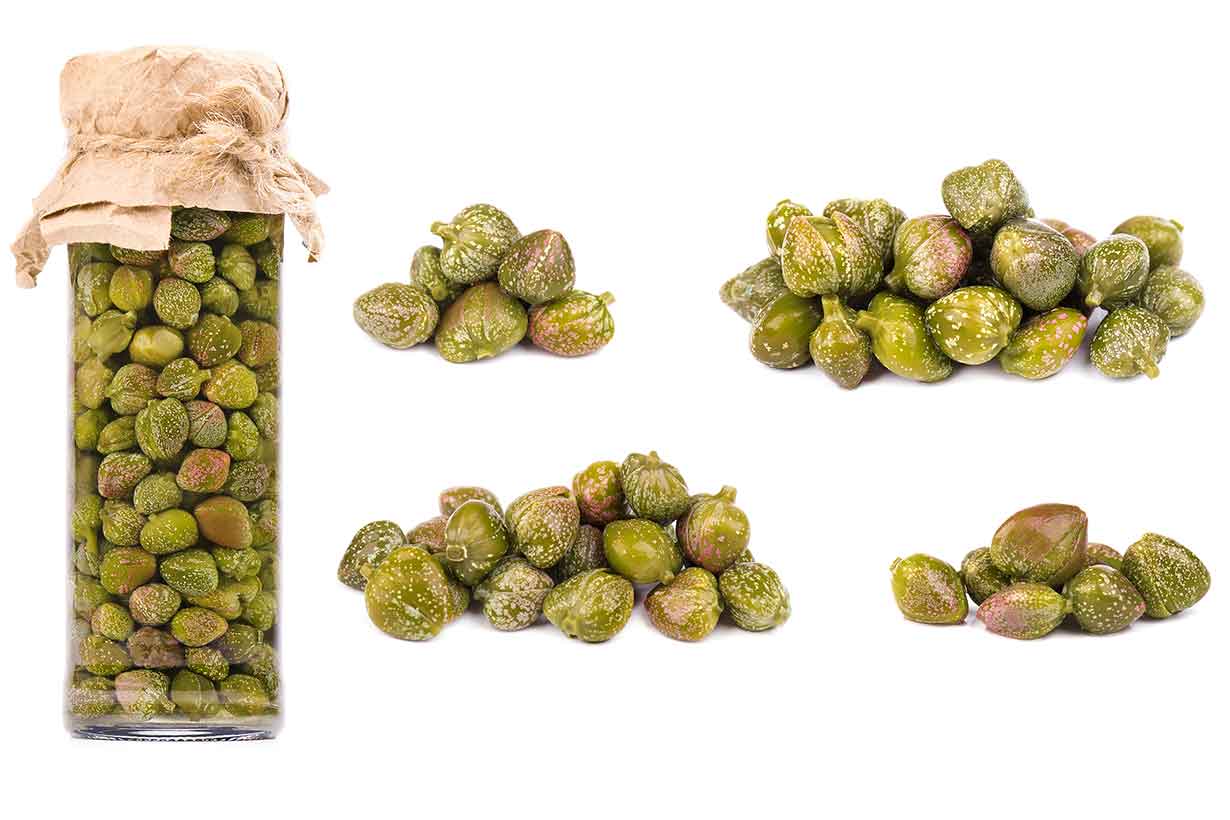Many fruits are available to buy, and they come in various colors.
A color shared by numerous fruits is purple; do purple fruits have any unique properties or benefits?
This article provides a list of purple fruits and examines some of their nutritional benefits.
Table of contents
Which Fruits Are Purple and What Gives Them Their Color?
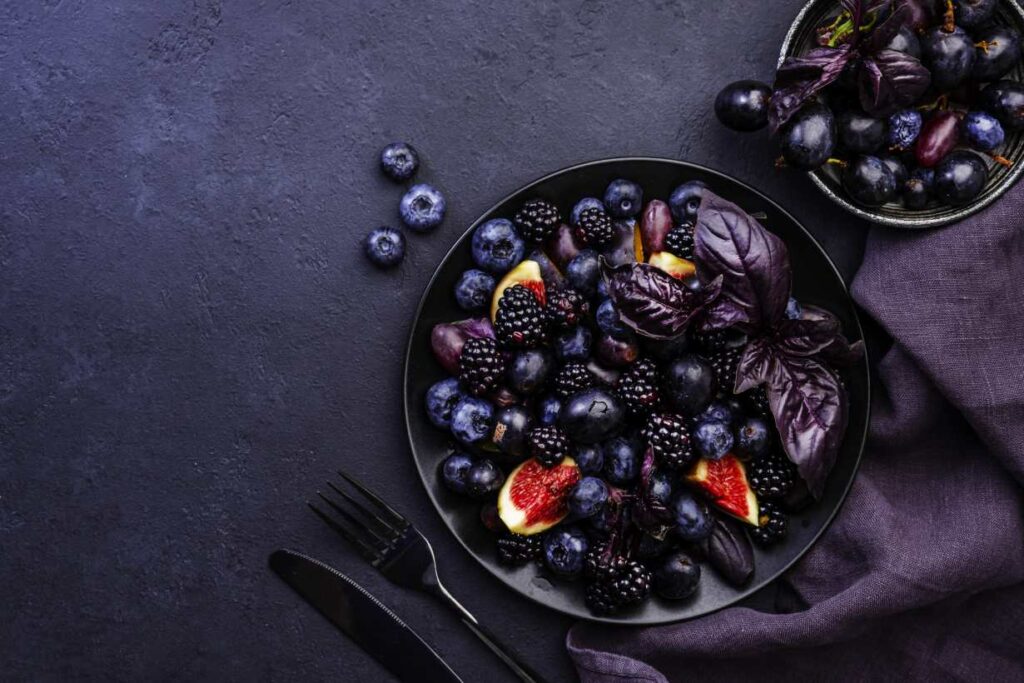
There are several varieties of fruit with purple flesh or skin, including several types of berries and stone fruits.
The common characteristic between these fruits and their purple color are their phytochemical content. These phytochemicals include a group of flavonoid polyphenols known as anthocyanins, which can have blue, red, and purple pigments (1).
In addition to purple fruits, anthocyanins are also found in varieties of red fruit.
Flavonoid polyphenols are a bioactive phytochemical found in plant foods. This means they can have a biological effect on the human body (2).
It is often possible to see claims of anthocyanins having health benefits in the media. Some of the most popular sources of these compounds include blueberries, grapes, and red wine.
Do Purple Fruits Have Any Unique Nutritional Benefits?
Firstly, as with most fruits, the most common nutrient in purple fruit is vitamin C. However, purple fruits may have some unique nutritional benefits due to their anthocyanin content.
For example, a 2023 systematic review and meta-analysis examined 21 clinical trials and 27 pre-clinical trials on the effect of anthocyanins on type 2 diabetes and obesity. This study demonstrated that anthocyanin-rich foods significantly lowered fasting blood glucose and LDL cholesterol (3).
Furthermore, a 2021 systematic review and meta-analysis of 44 randomized controlled trials and 15 observational studies found that anthocyanin supplementation significantly reduced LDL cholesterol and decreased C-reactive protein, with the latter being a marker of inflammation (4).
Over the longer term, anthocyanin intake may potentially have protective effects on health.
In this regard, a 2019 systematic review and meta-analysis of long-term cohort (observational) studies found a link between a higher intake of anthocyanin foods and reduced risk of coronary heart disease mortality and cardiovascular disease mortality (5).
A List of Purple Fruits
In alphabetical order, here is a list of some of the most common purple fruits alongside some of their nutritional properties.
Daily values (% DV) have been calculated using USDA data and the FDA’s published daily values.
1) Acai Berries
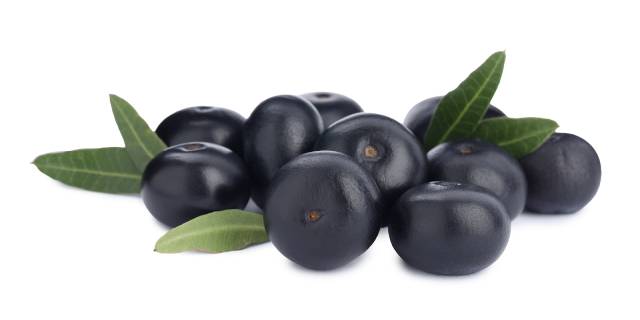
Acai berries are purple berries native to South America (6).
The berries contain high levels of anthocyanins, which gives them their deep purple color (6, 7).
Acai berries are also a good source of essential nutrients, including manganese, zinc, iron, and calcium (8).
On the downside, it is tough to find fresh or frozen acai berries for sale aside from the local areas where they grow. For this reason, acai berries are mostly consumed as drink products and berry powders.
2) Bilberries
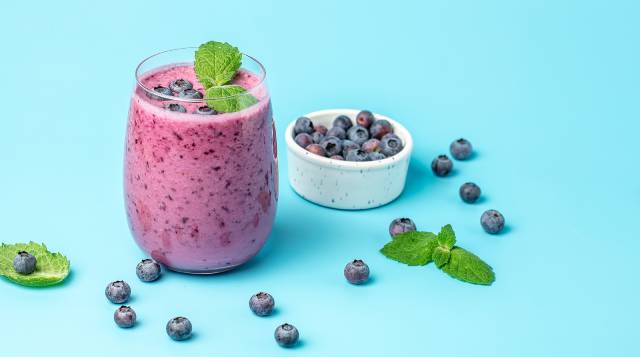
Bilberries are blue-to-purple-colored berries with a similar appearance and nutritional composition to blueberries.
Sometimes known as ‘European blueberries,’ these berries are one of the most anthocyanin-rich and are thought to contain more than many other berries (9).
Among the nutrients they contain, bilberries are particularly high in manganese, offering 0.50 mg per cup, which is 22% of the daily value (10).
Key Facts (Per 148g cup of bilberries)
- Calories: 84 kcal
- Carbohydrates: 21.5 g
- Fiber: 3.55 g
- Sugars: 14.7 g
- Fat: 0.49 g
- Protein: 1.1 g
- Key nutrients: Manganese (22% DV), vitamin C (20% DV)
3) Blackberries
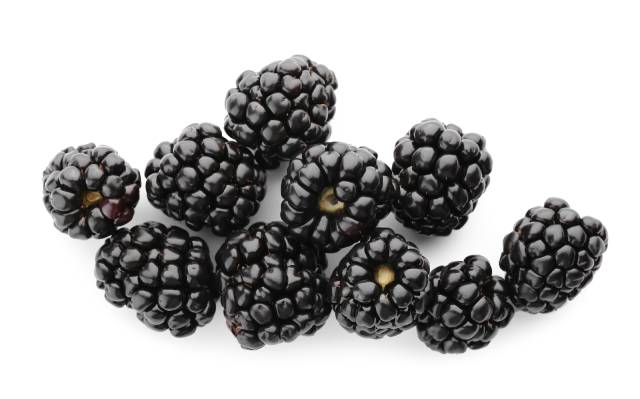
Blackberries are one of the most polyphenol-rich berries, with a deep purple-to-black color (10).
A human trial showed that urinary excretion of anthocyanin metabolites significantly rises after consuming 200 grams of blackberries (11).
The purple color of blackberries comes from their anthocyanin content. Cyanidin-3-O-glucoside accounts for 94% of the anthocyanin content of blackberries (12).
Blackberries provide an excellent source of vitamin C. Each cup serving provides 30.24 mg, 34% of the daily value (13).
Although they are seasonal produce, they are widely available in their frozen form.
See here for more information on the key differences between fresh and frozen produce:
Fresh vs. Frozen Fruit & Vegetables: Which Is Better Nutritionally?
Key Facts (Per 144g cup of blackberries)
- Calories: 62 kcal
- Carbohydrates: 13.8g
- Fiber: 7.63 g
- Sugars: 7.03 g
- Fat: 0.71 g
- Protein: 2.0 g
- Key nutrients: Manganese (40% DV), vitamin C (34% DV)
4) Blackcurrants
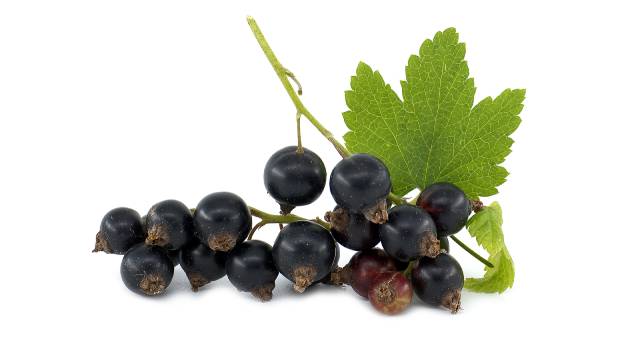
After previously being restricted, blackcurrants are now growing commercially in the United States. They are also widespread throughout Europe.
These dark purple to black berries have a tart taste. Their purple color comes from their content of fifteen different anthocyanins, primarily cyanidin and delphinidin (14).
In addition to their usage as a fresh berry, numerous blackcurrant commercial products such as juices, jams, and jellies are available.
Blackcurrants provide a significant source of vitamin C. A cup serving provides 203 mg, 226% of the daily value (15).
Key Facts (Per 112g cup of blackcurrants)
- Calories: 71 kcal
- Carbohydrates: 17.2g
- Fat: 0.46 g
- Protein: 1.57 g
- Key nutrients: Vitamin C (226% DV), copper (16% DV)
5) Blueberries
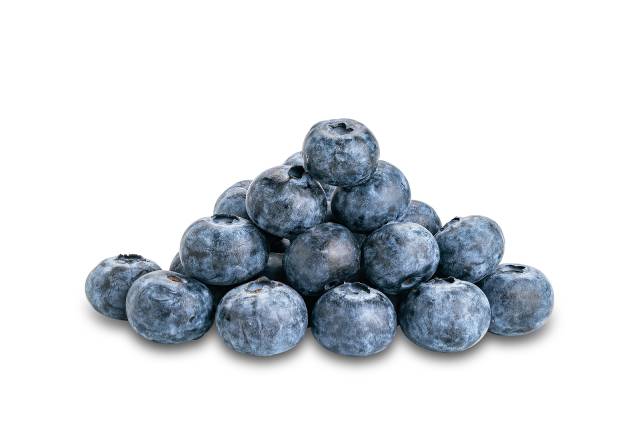
Blueberries are among the most popular commercial berries, with a dark blue to light purple color.
This purple pigment in blueberries comes from their anthocyanin content. Research in this area has shown that fresh blueberries have a total anthocyanin content of 7.2 mg per gram (16).
Blueberries are typically consumed alone, with other berries, in yogurt or porridge, or in juices and smoothies.
The primary essential nutrient in blueberries is manganese; a 148g cup serving provides 22% of the mineral’s daily value (17).
Key Facts (Per 148g cup of blueberries)
- Calories: 84 kcal
- Carbohydrates: 21.5g
- Fat: 0.49 g
- Protein: 1.1 g
- Key nutrients: Manganese (22% DV), vitamin C (20% DV)
6) Elderberries
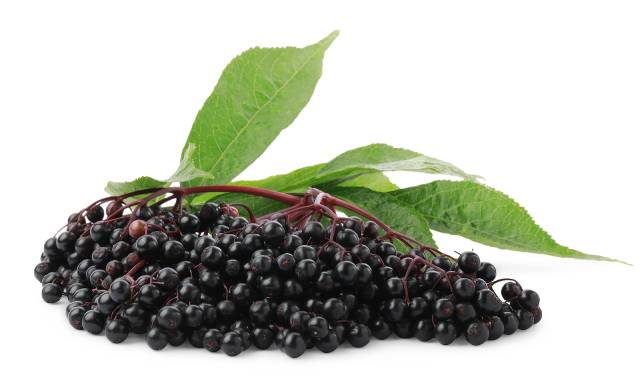
Elderberries have a bitter and tart taste, so they are rarely consumed as whole berries. Instead, elderberries feature in a wide range of jams, teas, and drinks.
Nineteen different anthocyanins have been detected in elderberries, mainly cyanidin-3-O-sambubioside and cyanidin-3-O-glucoside (18). These anthocyanins are responsible for the dark purple color of the berries.
Nutritionally, elderberries are a rich source of vitamin C. A cup serving contains 52.2 mg, 58% of the daily value (19).
Key Facts (Per 145g cup of elderberries)
- Calories: 106 kcal
- Carbohydrates: 26.7 g
- Fiber: 10.2 g
- Fat: 0.73 g
- Protein: 0.96 g
- Key nutrients: Vitamin C (58% DV), vitamin B6 (19% DV)
Learn more about elderberries: Elderberries: 5 Potential Benefits and Full Nutrition Facts
7) Kalamata Olives
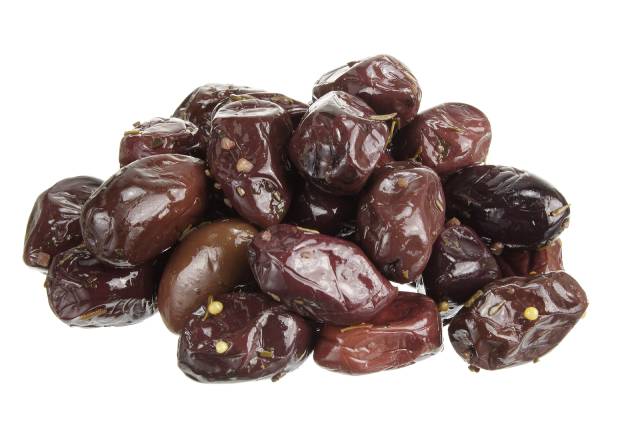
Despite their lack of sweetness, olives are a botanical fruit.
Kalamata olives, sometimes called “purple olives,” are among the most popular varieties.
Kalamata olives are a rich source of polyphenols, including anthocyanins such as cyanidin-3-rutinoside and cyanidin-3-glucoside (20).
Since typical olive servings are only small, they provide minimal levels of vitamins and minerals.
Key Facts (Per 15g serving of kalamata olives)
- Calories: 17 kcal
- Carbohydrates: 0.91 g
- Fiber: 0.24 g
- Fat: 1.64 g
- Protein: 0.13 g
- Key nutrients: Iron (4% DV), sodium (3% DV)
8) Mangosteen
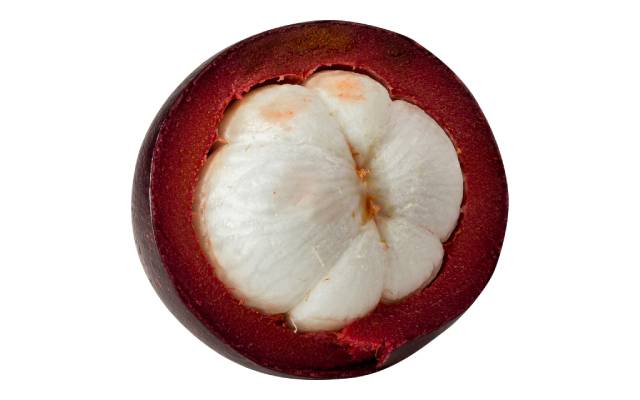
Mangosteen is a popular tropical fruit with purple skin enclosing white flesh in the middle.
While the purple peel of mangosteen is rich in anthocyanins, the part that we eat—the flesh—has relatively little (21).
Based on data from the NCC Food and Nutrient Database, mangosteen’s highest micronutrient content comes from folate. A 100-gram serving offers 31 mcg, 8% of the daily value (22).
Key Facts (Per 100g serving of mangosteen)
- Calories: 73 kcal
- Carbohydrates: 17.3 g
- Fiber: 0.9 g
- Sugars: 16.4 g
- Fat: 0.50 g
- Protein: 0.60 g
- Key nutrients: Folate (8% DV), manganese (5% DV)
Source: NCC Food and Nutrient Database
9) Maqui Berries
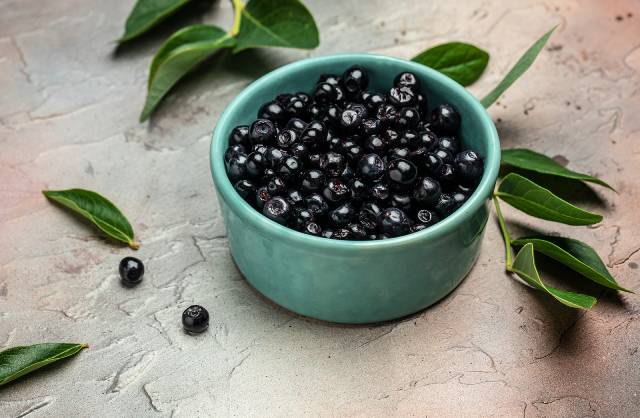
Maqui berries are dark purple berries native to South America. Like acai berries, it isn’t easy to see fresh maqui berries. However, there is a range of supplements and powdered drink products available.
The dark purple pigmentation of maqui berries comes from their rich anthocyanin content. A 2006 study found that maqui berries’ average total anthocyanin content is 137.6 mg per 100 grams of fresh fruit (23).
Unfortunately, there is currently a lack of reputable data on the nutritional composition of maqui berries.
10) Passion Fruit
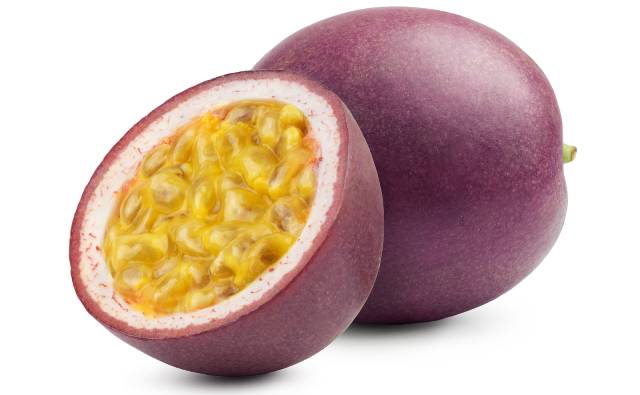
Like mangosteen, passion fruit is a tropical fruit with an anthocyanin-rich purple peel. However, the yellow flesh of the fruit has lower levels of anthocyanins (24).
See this guide to yellow fruits for more on yellow-pigmented fruit.
Passion fruit is commonly eaten with a spoon but is also a popular ingredient for juices, smoothies, and yogurts.
Nutritionally, passion fruit provides high levels of vitamin C; a cup serving offers 73.6 mg, 82% of the daily value (25).
Key Facts (Per 247g cup serving of passion fruit)
- Calories: 126 kcal
- Carbohydrates: 33.6 g
- Fiber: 0.49 g
- Sugars: 33.1 g
- Fat: 0.12 g
- Protein: 0.96 g
- Key nutrients: Vitamin C (82% DV), riboflavin (24% DV)
11) Plums
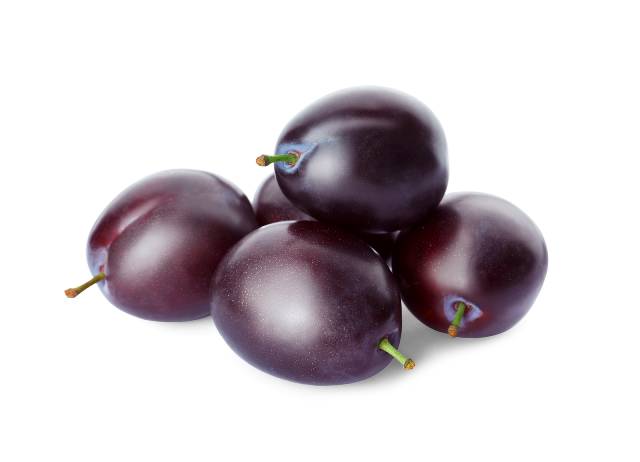
Plums are popular purple stone fruits.
The purple skin of plums is due to the purple-pigmented anthocyanins they contain. These anthocyanins are primarily cyanidin 3-rutinoside and peonidin 3-rutinoside (26).
Plums are one of the most popular commercially available fruits, and they can be eaten alone or used as an ingredient in desserts, jams, and numerous recipes.
The primary micronutrient in plums is vitamin C; one plum provides 6.27 mg, which is 7% of the daily value (27).
Key Facts (Per 66-gram plum)
- Calories: 30 kcal
- Carbohydrates: 7.52 g
- Fiber: 0.9 g
- Sugars: 6.55 g
- Fat: 0.19 g
- Protein: 0.46 g
- Key nutrients: Vitamin C (7% DV), potassium (2% DV)
12) Prunes
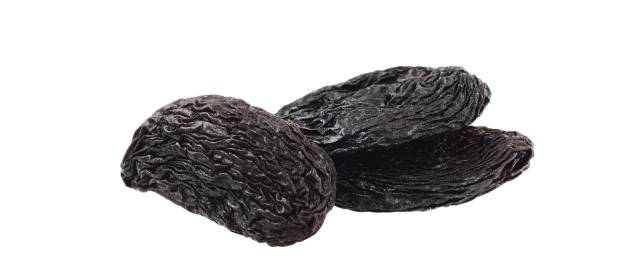
Prunes are dried plums, and they have a darker purple-to-black color.
Like fresh plums, dried plums (prunes) contain the anthocyanins cyanidin and peonidin, which contribute to their purple pigment (26).
Prunes are a little more versatile than fresh plums, and they can be used in cereals, drinks, desserts, trail mixes, yogurts, porridge, and more.
Nutritionally, prunes have a similar nutritional composition to plums but are typically consumed in greater quantities.
Key Facts (Per 40-gram, 5-prune serving)
- Calories: 96 kcal
- Carbohydrates: 25.6 g
- Fiber: 2.84 g
- Sugars: 15.2 g
- Fat: 0.15 g
- Protein: 0.87 g
- Key nutrients: Vitamin C (27% DV), potassium (6% DV)
13) Purple Star Apple
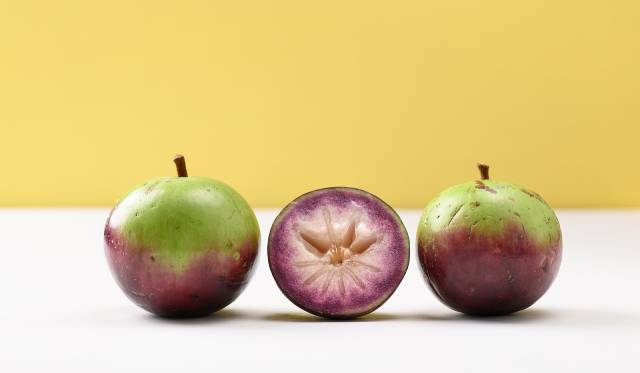
Purple star apple is a fruit with a unique purple flesh. Despite the name, star apples are botanically different from the common apple.
These purple star apples get their pigment from the range of anthocyanins they contain (27, 28).
The major nutrition databases currently don’t have an entry for purple star apples. However, initial research on the fruit has provided approximate nutritional values based on several samples, as shown below.
Key Facts (Per 100g portion of star apple)
- Calories: 67 kcal
- Carbohydrates: 14.65 g
- Fiber: 0.55 – 3.30 g
- Sugars: 8.45 – 10.39 g
- Protein: 0.77 – 2.33 g
Source: Hau V. Doan and Thao P. Le (2020)
14) Raisins
Raisins (dried grapes) have a dark purple to brown color.
However, the anthocyanin content of raisins can vary significantly depending on the grape the raisins came from. In this regard, raisins from red grapes have a much higher anthocyanin content than raisins from green (white) grapes (29).
Raisins are versatile dried fruits that can be used in savory and sweet recipes, cereals, yogurts, trail mixes, and more.
Nutritionally, raisins are a good source of copper; a 40-gram serving provides 0.11 mg, 12% of the daily value (30).
Key Facts (Per 40g serving)
- Calories: 120 kcal
- Carbohydrates: 31.7 g
- Fiber: 1.8 g
- Sugars: 26.1 g
- Fat: 0.1 g
- Protein: 1.32 g
- Key nutrients: Copper (12% DV), potassium (6% DV)
Commonly Asked Questions About Purple Fruits
For further information, here are some answers to common questions about purple fruits.
There are so many different varieties of purple fruits, but the number of commercially available purple fruits is more limited. One of the main reasons for this is that many berries and other fruits are either unsuitable for human consumption or are financially unviable for commercial production.
As shown within this guide, some purple berries are edible, including acai, bilberries, blackberries, blackcurrants, blueberries, and elderberries. However, dozens of purple berries growing in the wild are poisonous and thus not edible to humans. For this reason, it is essential not to consume any berry (or fruit) that hasn’t been appropriately identified.
Part of the health benefits we can attain from purple fruits comes from the nutrient composition of the fruits. In this context, most purple fruits offer a good amount of dietary fiber, vitamin C, and several other vitamins and minerals. Additionally, purple fruits are high in anthocyanins, a flavonoid polyphenol thought to benefit human health (3, 4, 5).
Final Thoughts
Purple fruits have much to offer nutritionally, from their fiber and micronutrient content to their high levels of anthocyanins.
Since most purple fruits are also enjoyable to eat, including a few within our diet can be a delicious way to improve our diet quality.

